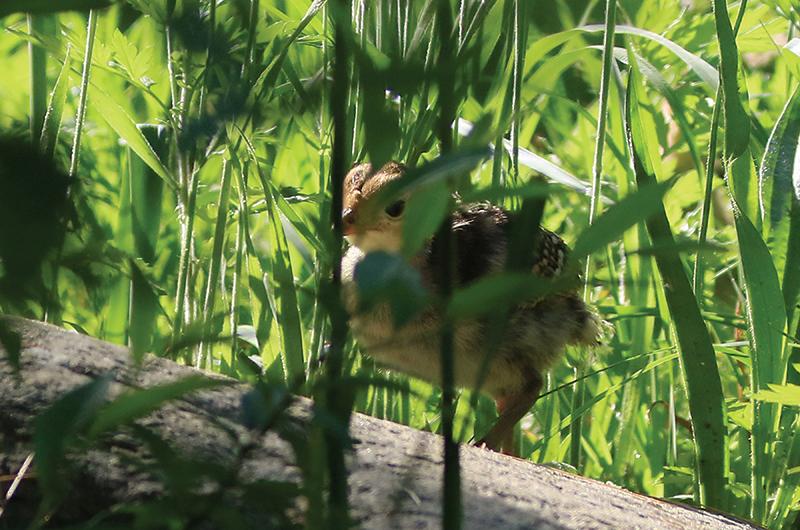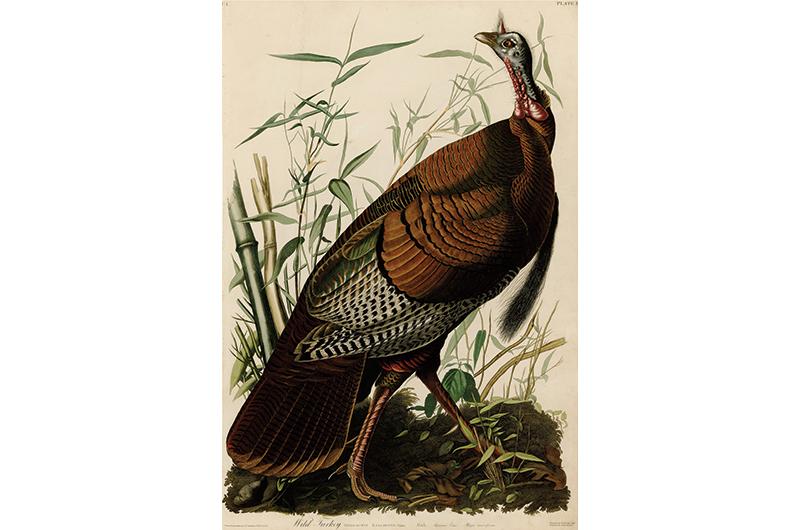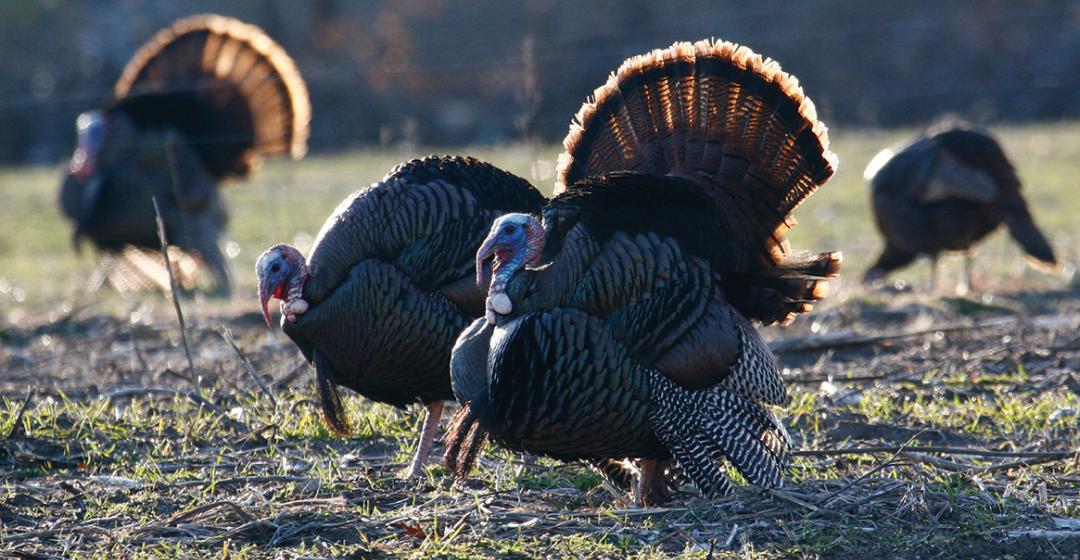There are sounds associated with life on Martha’s Vineyard. The cry of a seagull. The roar of the surf. A plaintive foghorn echoing in the night. But “gobble, gobble, gobble”?
Turkeys are well established on Martha’s Vineyard. And although the wild turkey is the official game bird of Massachusetts, there is little to suggest that the Island variety – which lean to the tamer side of the genetic road map – give a hoot about their designation on the state’s hunting hit list.
Turkeys are a common sight. They stroll across busy Island roadways with the nonchalance of a Boston jaywalker dodging traffic. They deposit their droppings on porches, snack at bird feeders, and raid backyard gardens.
During the spring mating season, approximately March through May, the sound of male turkeys gobbling in earnest to attract hens echoes in many Island neighborhoods. Toms, as male turkeys are known, regularly stroll along busy roads fanning their tails as they strut back and forth to impress choosy hens, rival Toms, and vehicle drivers stuck behind a timid motorist waiting for the turkeys to move off. Franklin Street in Vineyard Haven and Music Street in West Tisbury are popular turkey dating spots.
But make no mistake about it. A Tom with love on his mind is no chicken – he will fight. A big gobbler can weigh about sixteen to twenty-five pounds and wields a sharp, curved talon on each leg. This spur can grow up to two inches in length depending on the age of the bird. And a wild turkey has a top running speed of twenty-five miles per hour and can fly at fifty-five miles per hour, but only for a short distance.
Toms can be territorial and aggressive. Males will attack their reflections – as one did when he saw his spitting image on the side of a shiny, expensive, custom automobile in Vineyard Haven, causing considerable damage. On occasion, a turkey will even go after a person it ranks low in its pecking order.

In one notorious episode, now a part of Island lore, in June 2008 a bad-tempered turkey attacked two Chilmark police officers who had responded to a call about a turkey that had chased a delivery van driver and a companion from the area of Old Ridge Hill in Chilmark – that story ended poorly for the bird and has not ended for the cops.
One of the officers shot the turkey, and a nearby property owner who responded to the sound of gunfire was arrested for assaulting a police officer. Seems the man and his wife had grown fond of the turkey they’d nurtured and named Tom.
The subsequent teasing (and some amount of criticism) directed at the officer for taking four shots (or five depending on whose account you believe) to turn a live bird into a dead feather duster might have ended at Squid Row on Menemsha Harbor, a hangout where cynical, witty reflections on Island life are as common as comments about the weather.
However, Vineyard Gazette reporter Sam Bungey followed up on the story and its aftermath. A clever journalist who now lives in London, he turned the tale into “Murder Most Fowl,” a fifteen minute humorous radio essay for This American Life, a weekly public radio show heard by 2.2 million people on more than 500 stations.
Tom’s “reign of terror” and violent end in the woods of Chilmark has become a staple of NPR Thanksgiving Day programming, heard most years when families across America sit down to eat a bird that bears little resemblance to its free range wild cousins.
Wild turkeys (Meleagris gallopavo) were widespread when the first English colonists arrived in what is now Massachusetts. Two centuries later they had largely disappeared due to habitat loss and hunting, according to the Massachusetts Division of Fisheries and Wildlife (DFW). The last known native bird was killed in 1851 on Mount Tom in the Holyoke range in central Massachusetts.
Just for the record, the mountain was not named in honor of the dead bird. In the 1600s, Springfield settlement surveyor Rowland Thomas named the peak after himself – and probably bagged a few birds while he was tramping around thinking about posterity.

In the early 1900s various efforts were made to reintroduce turkeys to suitable forested areas of the state. This included a private effort in 1922 that released sixty-five turkeys on Naushon Island in the Elizabeth’s chain, a long glide for a big bird across Vineyard Sound. Over the years, DFW efforts to reintroduce turkeys focused on areas in central and western Massachusetts. Wildlife officials learned some important lessons from their failures. Chief among them, according to DFW biologist James E. Cardoza, author of The Wild Turkey in Massachusetts, was that game-farm or mixed ancestry birds were unsuitable for use in any further restoration efforts because they “lacked the inherent qualities of wildness necessary for the unsupported establishment of breeding populations.”
In the early 1970s DFW trapped thirty-seven wild turkeys in New York and released them in the Berkshires. By the fall of 1978 the estimated state population was about 1,000 birds. Today, it exceeds 30,000, according to DFW.
So what happened on Martha’s Vineyard? The answer is not entirely clear and gets lost in that curious fog of Island anecdote and natural history. But the Island flock did not originate with state efforts. Those were limited to the mainland.
David Scarpitti, DFW wild turkey and upland game biologist, said there is some evidence of turkey introductions on the Vineyard, whether wild or game-farm stock is unknown, dating back to the 1970s. He said Cardoza noted “that the turkeys in Edgartown and Tisbury were not terribly wary like true wild birds, but also had various physical characteristics that would indicate they were probably hybrids of domestic and/or game-farm turkeys.”
Irrespective, Scarpitti stops short of describing them as feral. He said the Island’s turkeys “are certainly free ranging and successfully breeding and surviving in the wild.”
West Tisbury native Joan Jenkinson has a good memory for animals. For twenty-seven years until her retirement in 2016 she was her town’s beloved animal control officer. Asked if she remembers seeing turkeys around West Tisbury when she was younger, Jenkinson, now seventy-four, said, “When I was a kid? No. They’re new and they call them wild turkeys, but I don’t know how wild they are.”
A practical Islander, she does not put much stock in the notion that today’s turkeys were set free by farmers. “I don’t think that people that raised turkeys to eat them would let their turkeys go,” she said.

The number of turkeys has grown exponentially in the up-Island town, particularly around Music Street. As for deterring them: “The best thing I’ve ever used is ground red pepper,” Jenkinson said. “They don’t like the taste of it on the ground.”
Laurie Clements, Tisbury animal control officer for more than thirteen years, admits at the start of a conversation that she has a soft spot for turkeys. Now sixty-three, Clements said she has no recollection of wild turkeys when she was growing up on the Island.
“There were none. The only thing I remember is the turkey farm on the Edgartown Road [where Hillside Village is today] that [George] Schwab owned and they were all white turkeys.”
The origin of the modern flock is a mystery. “I truly have no idea how they got here,” she said. “All of a sudden they just were here. I never gave it a thought.”
Clements said there was a time when calls about turkeys to animal control were about a dozen a year, but that is no longer the case. “Now I get none,” she said.
She thinks one reason is a decline in the larger residential flocks. She is uncertain what is responsible. As to remedies for afflicted homeowners, she recommends hanging tinsel, pie plates, putting up mirrors and pinwheels – “pinwheels are an awesome deterrent.”
Which begs the question: why? “I don’t know,” Clements said. “They don’t like the spinning of it.”

Barbara Prada, former Edgartown animal control officer, said turkeys are a problem in Edgartown, “but not like Vineyard Haven.”
Turkeys will peck and scratch at their reflection in cars, tap at windows, and “they poop all over.” Humans don’t help. “Some people will put food out for them which keeps them in one area,” she said.
Prada, who retired in 2019 after thirty-two years on the job, said turkeys only began to appear on her radar screen in the ’90s.
She advises people not to feed turkeys “because they can be really nasty, especially during mating season,” she added.
On the other side of the food ledger, she recalls a period during the ’90s when the Island’s building economy collapsed. One man took to snaring turkeys and putting them in his freezer. “He said it was good eating, and they are considered free-range turkeys,” Prada said. “He didn’t have a whole lot of money coming in, so he had to feed his family somehow.”
On the subject of the Island’s number one pest, do not look to the turkey for much help. DFW’s Scarpitti said turkeys may eat some ticks but it is probably inadvertent while feeding on acorns and other seeds. On the positive side, turkeys and birds in general are a poor host for deer ticks, he said, which generally prefer mammalian hosts such as cottontail rabbits, white-tailed deer, and mice.
With no natural predators, the Island turkey flock may be expected to keep expanding, a potential concern everywhere in the state, particularly in eastern Massachusetts. Asked what can be done to keep the population in check, Scarpitti is emphatic: stop feeding turkeys.
He recommends homeowners eliminate bird feeders altogether or keep bird feeding areas clean to minimize spilled seed on the ground. “This is the single most important thing to prevent the unnatural concentration of turkeys in populated areas,” he said.
While some consider Island turkeys to be feral, for the record, DFW considers Island birds to be wild game. To the extent that turkey hunting does take place on the Island in the fall and spring seasons, it is low key, and state officials assume underreported.
For example, only four turkeys were reported harvested during the four week 2018 spring season in all of Dukes County, which includes the Elizabeth Islands. And in 2016 that number was one.
Martha’s Vineyard birds aside, the truly wild turkey – which does not hang around people – inspires single-minded passion among its approximately two million fans and supports a billion dollar hunting industry across the United States, according to the most recent U.S. Fish and Wildlife Service survey hunting data. More than seventy years ago, author G.T. Klein summed it up when he said that turkeys are “wild and wary to the point of genius.” On the other hand, he said, those who raise domestic turkeys “will be disgusted with their dumbness.”
Founding father Benjamin Franklin was far more impressed with the wild turkey than the bald eagle (though according to Smithsonian magazine, it is a myth that he wanted it named the national bird).
In a letter to his daughter, he addressed the subject of the turkey versus the eagle: “For in Truth, the Turkey is in Comparison a much more respectable Bird, and withal a true original Native of America….He is besides, (though a little vain & silly….), a Bird of Courage, and would not hesitate to attack a Grenadier of the British Guards who should presume to invade his Farm Yard with a red Coat on.”
Thinking back to the incident of Tom and the Chilmark police, perhaps it was all just a fatal case of mistaken identity.




 2 comments
2 comments
Comments (2)